LoCoFlo Blog
Tags: At LoCoFlo BookClub Bugs Classes Farmers Flower Club Flower Profile Games Open Studio Hilarious Meet the Owners Nerdy AF Sat@LoCoFlo Stuff You Can Buy
January 13 2024
Growin' with the 'Flo
Tags: FarmersHey, did you know all of our flowers are locally grown. We do our best to buy flowers grown as close to the shop as we can. Here is a list of our farmers, how far away they are from us and some amusing anecdotes:
- Hillen Homestead - 3 miles
Maya is the man, and one of our main growers. - Florxeight - 4 milesCut garden roses grown in Baltimore WHAT!
- Juniper Farm - 11 miles
Sarah grows a unique mix of flowers, foliage and branches. She's been a friend and client for many years and now she's a supplier! - Butterbee Farm - 14 miles
Laura Beth provides the most flowers for us and she's totally normal. - Belvedere Farm - 18 miles
Bill, Beth and fam are the bomb. - Flowers By Bauers - 25 miles
Their hydroponic growing provides us flowers all winter. - Bloomhouse - 28 miles
Former best friends Jess and Sam are making a go of it as part-time flower farmers. - Two Boots Farm - 30 miles
Elisa is small but strong, and grows flowers too! - Plant Masters - 35 miles
We've been working with Leon and Carol since 2011. - Cut Flowers by Clear Ridge - 43 miles
This family run nursery added cut flowers just for us. - Tierra Blooms - 48 miles
Jackie used to grow vegetables. Now she grows flowers. That is way more doper. - M&M plants - 50 milesMadgie is one of the Ms.
- Belle Blooms Farm - 52 miles
Flowers and animals on this farm. - Locust Point Flowers - 58 miles (100 yards from the farmers market) John is curmudgeonly, but convenient.
- Midsommar Farm - 66 milesThey got your etched salmon.
- Hendricks - 81 miles
Hendricks is our main winter supplier. There is nothing colder than Lititz in February. - Seaberry Farm - 93 miles
Wenfei and Rick have planted an impressive orchard in Easton. Ask Josh about Stranger Things. - Wollam Gardens - 99 miles
Bob is flower OG. - Van Dyk Bros - 111 miles
Old man McKeown (Locust Point Flowers) gets us the tulip hook-up through Van Dyk. - Winters Farm Florals - 127 miles
Dani is the nicest! We always love when she delivers. Her quality and selection is top notch. - Battenfeld's - 284 miles
Batenfeld's always comes through for us when we are short in the winter.
June 27 2022
Think Global, Buy Local Flowers
Tags: FarmersSupply chain issues are widespread due to the pandemic. Flower imports are no exception. Additionally, a new problem is further disrupting the flower supply in the US - political protest in Ecuador.
Ecuador accounts for 10% of the world's flower exports with over $2 million shipped every day. Flower exports have been cut in half since protests began in mid June 2022.
Indigenous Ecuadorians have been "warming the streets" according to Eduardo Letort, CEO of Hoja Verde and President of Cayambe Association of Floraculture, in advance of elections next year. In a conversation on The Flower Podcast Letort described his experience trying to export flowers from Ecuador.
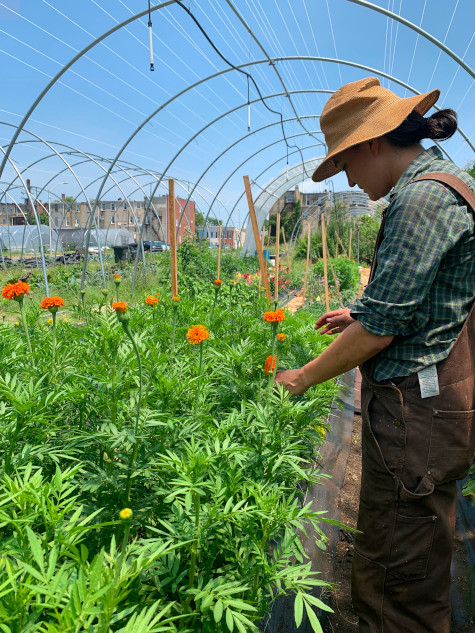
Protestors have blocked access to the airport and seized flower deliveries in their effort to lower gas prices, obtain assistance for small farms, and limit oil mining expansion, among other demands. Protestors have also been recruiting workers directly on the farms.
Letort has had to close operations when his workers leave to protest or to avoid potential violence. He has also resorted to paying bribes to pass blockades and delivering flowers to the airport by foot off-road and at night .
Wholesalers and florists in the US are noticing the disruption. Delays for orders and substitutions of varieties are increasingly common. Locally grown flowers have been one source to fill the need. Our growers have seen an increase in demand during the pandemic and again now with this additional supply disruption.
Flowers are an emotional and political product. Amy Stewart documented "the absurd arrangement" of the global flower market in her influential book, Flower Confidential. It is, for us, a maddening "intersection of nature and technology, of sentiment and commerce" and also climate concerns.
Buy local flowers! Viva Ecuador!
Tweet CommentsJune 21 2022
Farmer Fat Stacks
Tags: Classes, FarmersGet ready to make some money! Ellen has launched her second online class with The Gardener's Workshop. Preparing to Sell to Florists is an on demand insider's workshop for flower growers who want to sell directly to florists.
Ellen shares what florists want from their flower providers and how to sell to them from over a decade of buying directly from the farm focusing on three topics:
- Finding The Right Florist Customers
- How to Price Your Product
- All About Availability Lists
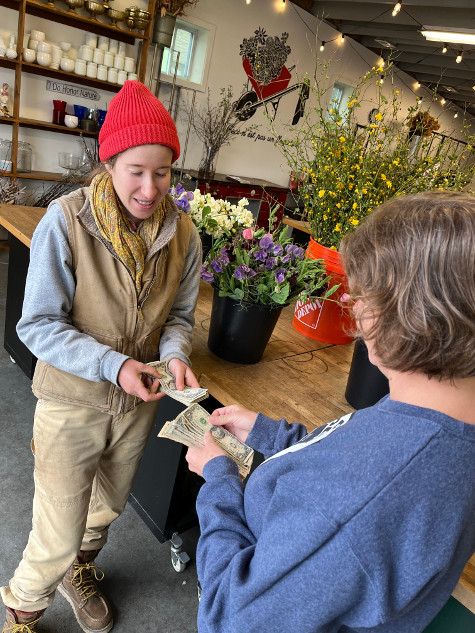
How It Works
Sign up anytime. It's an on demand workshop. Go at your own pace - it's about two hours. There's even a no questions asked money back guarantee. If you purchase the class before July 4 2022, you will be invited to a live Q&A with Ellen!
Learn More
This class is for anyone who wants to sell flowers directly to florists. You might be a big, multi-generation farm looking for a new sales outlet or a hobbyist aspiring to upgrade to a side hustle. You will learn how florists work, how to compete with wholesalers, how to define your value proposition, how to pitch your product, and how to build an ongoing successful business relationship.
Don't just believe this rando blog. Hear Ellen talk about this class on the Field and Garden podcast. Get your bag!
Tweet CommentsJanuary 07 2021
What We Do in the Winter
Tags: FarmersProcuring locally grown flowers is hard enough when conditions are optimal in our region. Winter really tests our mettle. Not only do we persist, we thrive! It takes some changes - for us, for our growers, and for our customers.
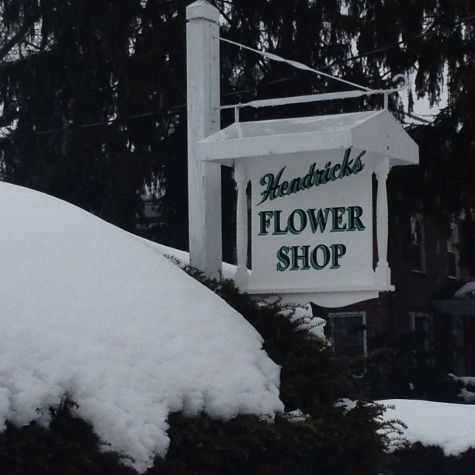 Hendricks is our main winter supplier
Hendricks is our main winter supplier
Supply, logistics, products, expectations all shift. It's only natural - a rhythm that brings new and wonderful flowers, foliage, branches, berries and more into our shop. It also brings, to borrow from Future Islands, a craving for what has gone away - the local variety of spring, summer and fall field flowers.
Ellen was a guest blogger for Botanical Brouhaha (and was interviewed on their podcast). She detailed all of her challenges and what life is like for a local-only florist when the fields freeze. Read all about what we do in the winter.
Tweet CommentsAugust 07 2019
Hunnid Bands Bucket
Tags: Farmers, Flower ProfileWe got the Money Plant. It has a lot of names and a lot of stories. And it's weird: how it looks, how it grows, how to harvest it, how we prep it, how we use it. Even how we get it. All of this makes it one of our favorites.
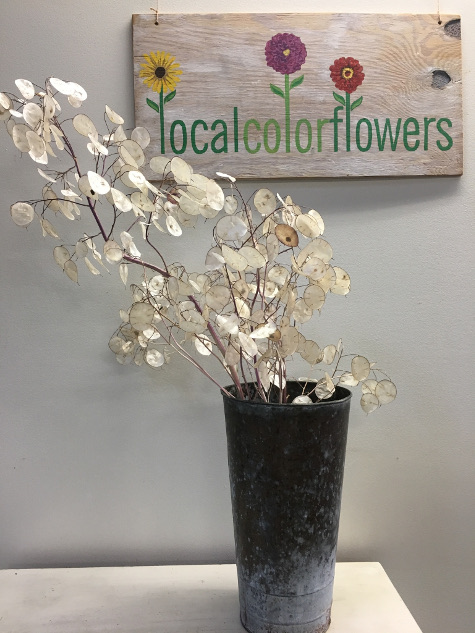
Lunaria (from the Latin meaning moon-shaped) is the botanical name. Money Plant is the most popular common name. It is also called Chinese Coins, The Pope's Money, Silver Dollar and Coins of Judas. Obviously, the unique silver color and flat round shape of the seed pods are what gives Lunaria so many monetary nick-names.
Not to be outdone by Jess, Stacy grew ours. It's a biennial. Stacy planted the seeds last Fall and it sprouted up this Spring. Lunaria is easy to naturalize - it reseeds itself. Set it and forget it. When they're young, they flower and their seed pods are green. As they season, the seed pods brown and the stem turns a pied purple. The signature silver color of the pod is achieved by letting the plant age in the ground. But that is when the work begins.
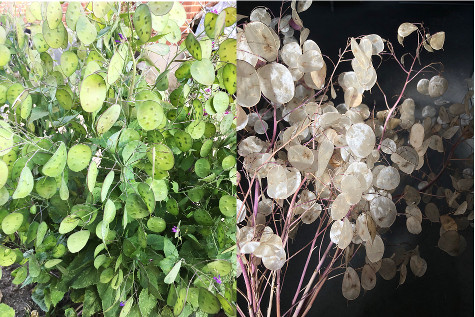
After cutting the plant, each of the pods has a dull husk that needs to be peeled back, like gold foil on chocolate coins, to reveal the shiny silver disks. Do that 100 times per plant and it's finally ready to go. It's a real money shucker.
That's one reason so few people are growing it, but the response we get from customers is worth all the hassle. One Lunaria lover stopped by Open Studio because she remembered it growing in her grandmother's yard. The nostalgia even prompted her to pack Lunaria as her carry-on to share the memory on a trip to visit her mother in California. Yeah! Maryland flowers going to the west coast.
According to Feng Shui, the Money Plant is to be placed in the Bagua area of shop to enhance the energy of wealth and prosperity. We just display it among our other seasonal local flowers. It's a treasure, even if we are still looking for those hunnid bands.
Tweet CommentsJune 21 2019
What's Your Statice?
Tags: Farmers, Hilarious, Flower ProfileOurs is German. It's unremarkable all alone in a bucket straight from the farm. But Statice, Ellen says, is a floral work-horse. Old Reliable. AD ('All Day' if you are familiar with the confusing nickname of football player Adrian Peterson - sometimes misnomered AP). What I'm getting at is Statice is a hearty and versatile cut we use year-round from Winter wreaths to Summer bouquets. It's a two-way player. It's a multi-instrumentalist. It's a flower for all seasons. It gets the job done!
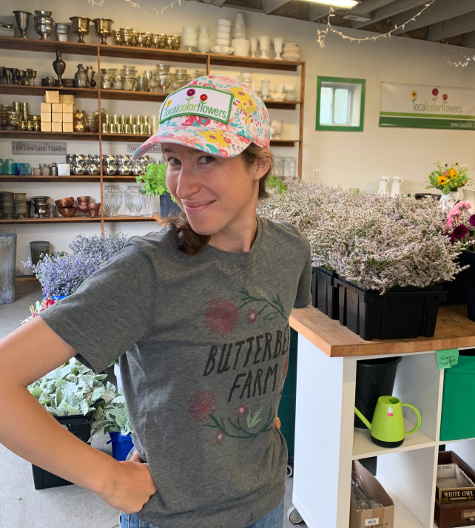
LB (status: sassy) with her Statice
And that's why Ellen loves herself some Statice. She also loves to enumerate:
- Statice looks the same fresh or dried (there's your versatility and longevity)
- Statice is a competent local substitute for the oft-requested and locally-scarce Baby's Breath
- With a name like 'Statice' the jokes write themselves. Baller.
- Statice is a staple for arrangements out of water: arches, bouts, head crowns, aisle swags and the such.
- Not a lot of growers sell it, so it provides a unique look in our arrangements.
Despite the high regard it holds today here at LoCoFlo, it took a few seasons for Statice to reach its current status (it didn't even get an at-large bid in last year's inaugural Flower Madness Tourney). Our first deliveries came from Greenstone Fields in 2014. After a few weeks, we saw the upside, and went all in. The next harvest, Ellen bought the entire crop.
Statice: flush.
As quickly as Statice came into our lives, it was gone. Hey Lloyd, Ellen was ready to be heartbroken (she really said 'heartbroken'). The Greenstone Statice bonanza lasted only one year.
Statice: sadness.
There were no other Statice growers nearby. Ellen started to recruit. Butterbee accepted the challenge and ordered up the plants from Dave Dowling at Gloeckner in the Fall of 2017. A year and a half later, we bought Butterbee's entire crop.
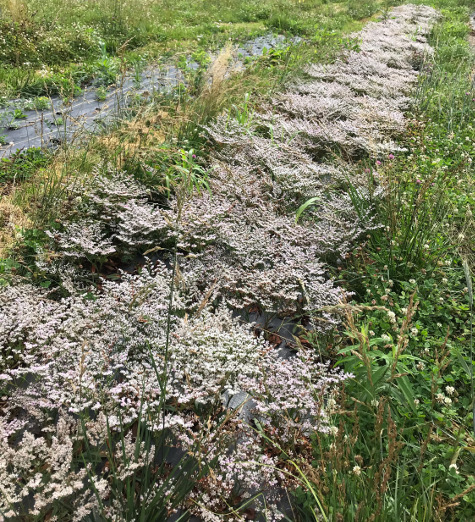
Statice: back in business.
Fake ending. More Statice. When LB delivered the Statice, local flower OG Bob Wollam came into the studio and said "Oh, you've got Limonium (fancy name for Statice). I used to grow a purple variety."
Statice: so many emotions.
Tweet CommentsJuly 31 2017
Baltimore In Bloom
Tags: FarmersLast weekend we were thrilled to host Dave Dowling, President of the Association of Specialty Cut Flower Growers and Mimo Davis of Urban Buds: City Grown Flowers in St. Louis Missouri for a whirlwind tour of flower farming in and around Baltimore.
We’re so proud of our Baltimore flower farming community and we were excited to introduce Baltimore to our out of town guests.
We started at the Sunday market to visit Elisa Lane of Two Boots Farm. Elisa started farming in Baltimore City when she co-founded Whitelock Community Farm in the Reservoir Hill. She and her husband now farm in Hampstead, Maryland. Each year she grows more and more flowers (because it’s addictive!)
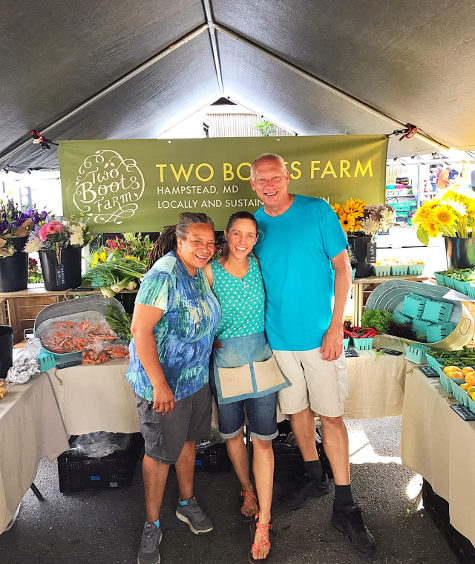
Next we headed over to Ananda Growers. Jen and Abhi are first year growers growing in East Baltimore in the shadow of Dr. King’s image. In addition to Ananda Growers, Jen also runs a youth farming program called Common Ground Youth Farming as part of her OSI Fellowship.
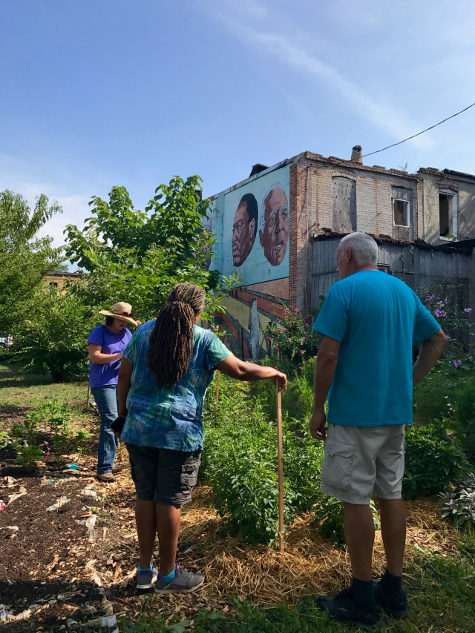
Next, we traveled a few blocks east to visit Walker at Tha Flower Factory. A big sunny half acre in the middle of East Baltimore, Tha Flower Factory is in it’s 2nd year of growing. Watch for big things from this urban farm.
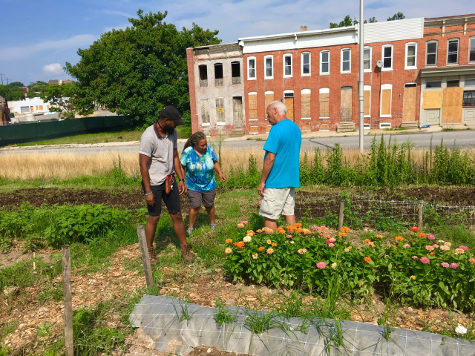
Next we headed north to Hillen Homestead. Maya has been growing flowers in Baltimore City for five years. With two sites, she is the biggest producer of flowers in the city.
At her original plot on Hillen Road, we checked out a plethora of gorgeous blooms including lisianthus, zinnias, love in a puff, snaps and amazing dahlias!
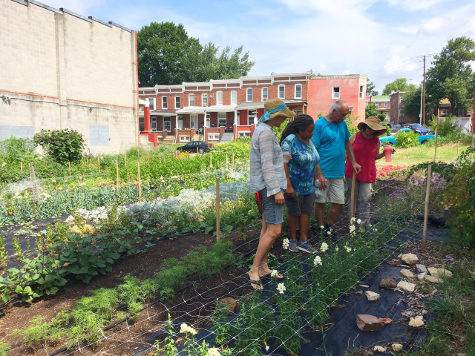
After a quick stop at the Crown gas station for a snack (Turkey Hill lemonade and chips for everyone…just call me…the hostess with the mostest”) we drove 45 miles west to visit our friends at PlantMasters. Mimo was especially excited to see Leon and Carol Carrier’s farm because of all of the ways the extend the season for sales in early spring and late fall/winter. Their new hoophouse is filled with gorgeous Cafe Au Lait dahlias.
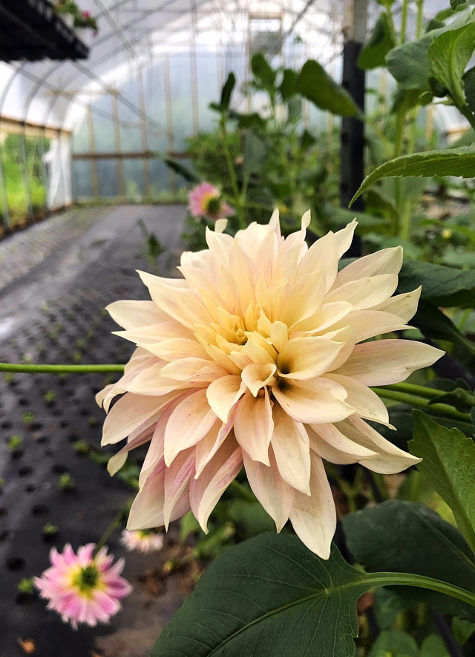
Of course, we couldn’t be touring around without Bob Wollam getting in on the action. It was pretty great to see these two flower friends reunited.
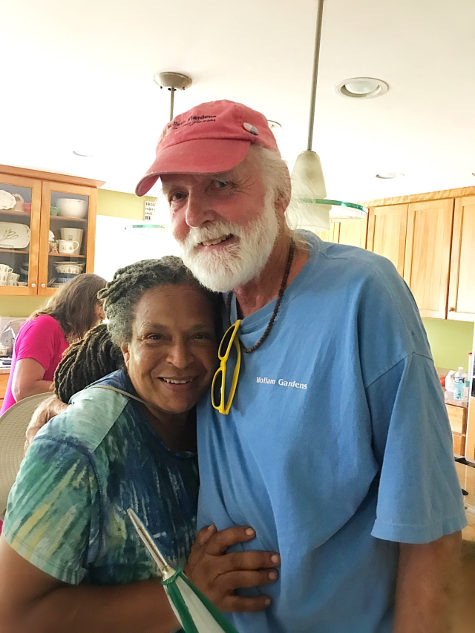
Our last stop on the tour was Endless Row Farm, owned by Leon and Carol’s son Lee. The name is so fitting! This farm is so beautiful! It reminded us all of the wide rows at Mel Heath’s farm.
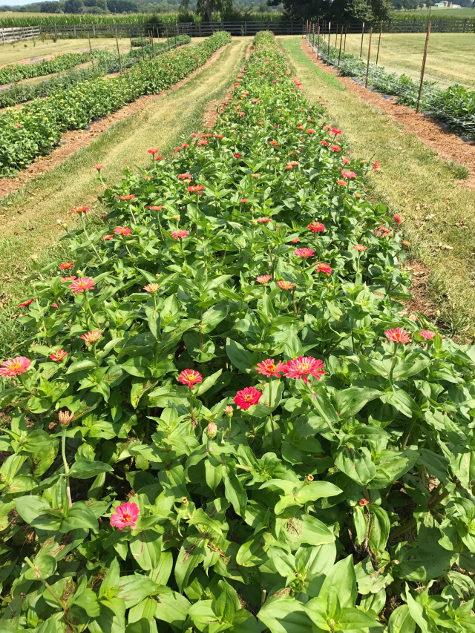
As we headed back to Butterbee Farm for dinner, my heart was so full. I’m beyond grateful to be part of this amazing flower farming community. From teeny tiny first year farms, to farms that have been producing local blooms for over 30 years, all of these growers play a crucial role in making the Mid-Atlantic such a special place for growing flowers.
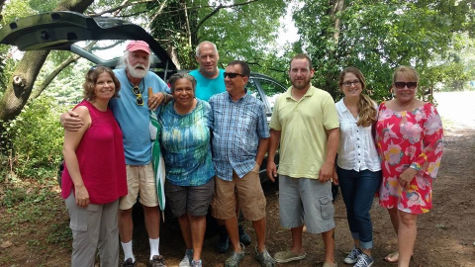 Tweet
Comments
Tweet
CommentsNovember 19 2016
Getting Smart and Sciencey at the Flo
Tags: Farmers, Nerdy AFSpent some time this week with amazing Chris Wien, Emeritus Faculty member at Cornell who continues to do valuable cut flower research in his retirement. Flowers growers in our region cheered a few years ago when this giant in the cut flower world decided to make Annapolis his new home after leaving Ithaca. 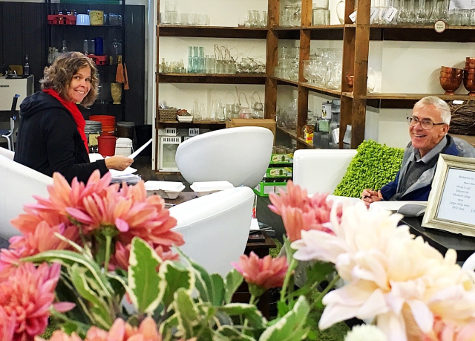
This week, the designers and I got to contribute our experience with lisianthus to be included in his research on spacing, stem production and bloom time. We also got to here all about the creation of the black pear pepper and it’s journey to market beginning at the USDA research lab in Beltsville.
We’re so grateful to be part of this weird, wonderful flower growing community!
Tweet Comments





